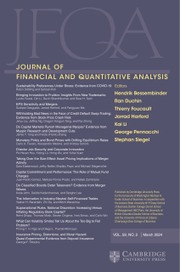Article contents
Securities Lending and Trading by Active and Passive Funds
Published online by Cambridge University Press: 23 January 2025
Abstract
U.S. mutual funds in the securities lending market extract information from stock borrowing. Active funds exploit this information, rebalancing away from borrowed stocks whose prices tend to decrease, whereas passive funds do not. Information spillovers within fund families are stronger when the lender is a passive fund and when the family is more cooperative (less competitive). Active funds trade more aggressively on stocks with more negative future returns, suggesting that they are able to identify informed borrowing. Finally, passive funds charge higher lending fees than active funds, consistent with short sellers paying a premium to lower recall risk.
Information
- Type
- Research Article
- Information
- Creative Commons
- This is an Open Access article, distributed under the terms of the Creative Commons Attribution licence (http://creativecommons.org/licenses/by/4.0), which permits unrestricted re-use, distribution and reproduction, provided the original article is properly cited.
- Copyright
- © The Author(s), 2025. Published by Cambridge University Press on behalf of the Michael G. Foster School of Business, University of Washington
Footnotes
I thank Hendrik Bessembinder (the editor), an anonymous referee, Thierry Foucault, Bruno Biais, Jean-Edouard Colliard, Denis Gromb, Johan Hombert, Daniel Schmidt, Huan Tang, and Filipe Correia for their generous comments and advice.
Funding Statement: This research is supported by the Finnish Foundation for Economic Education and the Investissements d’Avenir Labex (ANR-11-IDEX-0003/Labex Ecodec/ANR-11-LABX-0047) grant.
References
- 2
- Cited by

